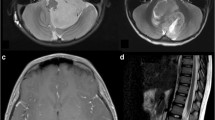Abstract
The determination of optimal therapy for ependymoma (EP) in infants is ongoing. We describe the incidence, management and outcomes of Canadian infants with EP to discern potential future research questions. Of 579 cases registered in a national database of children <36 months of age diagnosed with a brain tumor from 1990 to 2005, inclusive, 75 (13 %) were EP. These cases were analyzed. A mean annual age-adjusted incidence rate of 4.6 per 100,000 children years was calculated. The male:female ratio was 1.77. Of the tumors, 80 % were infratentorial in location, 67 % were WHO grade II histology, and 29 % were metastatic at diagnosis. All patients underwent a surgical procedure. A complete resection of the tumor was achieved in 56 % of the cases; 43 % of these patients survive while 36 % of the patients with tumors less than completely resected survive. Initial therapy consisted of surgery alone in 23 % of patients, or surgery plus chemotherapy (37 %), radiation therapy (RT; 19 %), or both (21 %). Any use of RT increased with patient age. The 5-year EFS rates for patients in each of the four treatment groups was 22, 11.5, 46.2 and 64.8 %, respectively. For all patients the median survival was 63 ± 6 months and 5-year overall survival was 55 ± 6 %. Patients treated with surgery and chemotherapy alone were younger and had a lower rate of survival than older patients who were more often treated with radiation therapy containing regimens. Further study is needed to determine which patients are optimally served with these treatment modalities.


Similar content being viewed by others
References
Bouffet E et al (1998) Intracranial ependymomas in children: a critical review of prognostic factors and a plea for cooperation. Med Pediatr Oncol 30(6):319–329 discussion 329–331
Rickert CH, Paulus W (2001) Epidemiology of central nervous system tumors in childhood and adolescence based on the new WHO classification. Childs Nerv Syst 17(9):503–511
Kaderali Z, Lamberti-Pasculli M, Rutka JT (2009) The changing epidemiology of paediatric brain tumours: a review from the Hospital for Sick Children. Childs Nerv Syst 25(7):787–793
Cohen BH et al (1993) Brain tumors in children under 2 years: treatment, survival and long-term prognosis. Pediatr Neurosurg 19(4):171–179
Massimino M et al (2011) Infant ependymoma in a 10-year AIEOP (Associazione Italiana Ematologia Oncologia Pediatrica) experience with omitted or deferred radiotherapy. Int J Radiat Oncol Biol Phys 80(3):807–814
Wright KD, Gajjar A (2009) New chemotherapy strategies and biological agents in the treatment of childhood ependymoma. Childs Nerv Syst 25(10):1275–1282
Duffner PK et al (1998) Prognostic factors in infants and very young children with intracranial ependymomas. Pediatr Neurosurg 28(4):215–222
Geyer JR et al (2005) Multiagent chemotherapy and deferred radiotherapy in infants with malignant brain tumors: a report from the Children’s Cancer Group. J Clin Oncol 23(30):7621–7631
Grill J et al (2001) Postoperative chemotherapy without irradiation for ependymoma in children under 5 years of age: a multicenter trial of the French Society of Pediatric Oncology. J Clin Oncol 19(5):1288–1296
Grundy RG et al (2007) Primary postoperative chemotherapy without radiotherapy for intracranial ependymoma in children: the UKCCSG/SIOP prospective study. Lancet Oncol 8(8):696–705
Rickert CH (1998) Epidemiological features of brain tumors in the first 3 years of life. Childs Nerv Syst 14(10):547–550
McGuire CS, Sainani KL, Fisher PG (2009) Incidence patterns for ependymoma: a surveillance, epidemiology, and end results study. J Neurosurg 110(4):725–729
Stiller CA, Bunch KJ (1992) Brain and spinal tumours in children aged under two years: incidence and survival in Britain, 1971–1985. Br J Cancer Suppl 18:S50–S53
Merchant TE et al (2009) Conformal radiotherapy after surgery for paediatric ependymoma: a prospective study. Lancet Oncol 10(3):258–266
Netson, KL et al (2012) A 5-year investigation of children’s adaptive functioning following conformal radiation therapy for localized ependymoma. Int J Radiat Oncol Biol Phys 84(1):217 e1–223 e1
Duffner PK et al (1999) The treatment of malignant brain tumors in infants and very young children: an update of the Pediatric Oncology Group experience. Neuro Oncol 1(2):152–161
Garvin JH Jr et al (2012) Phase II study of pre-irradiation chemotherapy for childhood intracranial ependymoma. Children’s Cancer Group protocol 9942: a report from the Children’s Oncology Group. Pediatr Blood Cancer 59(7):1183–1189
Godfraind C et al (2012) Distinct disease-risk groups in pediatric supratentorial and posterior fossa ependymomas. Acta Neuropathol 124(2):247–257
Witt H et al (2011) Delineation of two clinically and molecularly distinct subgroups of posterior fossa ependymoma. Cancer Cell 20(2):143–157
Kilday JP et al (2009) Pediatric ependymoma: biological perspectives. Mol Cancer Res 7(6):765–786
Korshunov A et al (2010) Molecular staging of intracranial ependymoma in children and adults. J Clin Oncol 28(19):3182–3190
Conflict of interest
The authors declare that they have no conflict of interest.
Author information
Authors and Affiliations
Corresponding author
Rights and permissions
About this article
Cite this article
Purdy, E., Johnston, D.L., Bartels, U. et al. Ependymoma in children under the age of 3 years: a report from the Canadian Pediatric Brain Tumour Consortium. J Neurooncol 117, 359–364 (2014). https://doi.org/10.1007/s11060-014-1396-3
Received:
Accepted:
Published:
Issue Date:
DOI: https://doi.org/10.1007/s11060-014-1396-3




